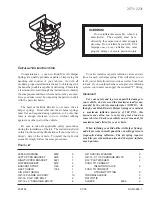
sive gases of a battery. There is a risk of an
explosion.
Before handling the battery, touch the vehicle
body to remove any existing electrostatic
build-up.
The highly flammable gas mixture is created
while the battery is charging and when jump-
starting.
Always make sure that neither you nor the bat-
tery is electrostatically charged. Electrostatic
charge is created, for example:
R
by wearing synthetic-fibre clothing
R
by friction between clothing and the seat
R
if you pull or push the battery across carpet or
other synthetic materials
R
if you rub the battery with a cloth
G
WARNING
During the charging process, a battery produ-
ces hydrogen gas. If a short circuit occurs or
sparks are created, the hydrogen gas can
ignite. There is a risk of an explosion.
R
Make sure that the positive terminal of a
connected battery does not come into con-
tact with vehicle parts.
R
Never place metal objects or tools on a bat-
tery.
R
It is important that you observe the descri-
bed order of the battery terminals when
connecting and disconnecting a battery.
R
When jump-starting, make sure that the
battery poles with identical polarity are
connected.
R
It is particularly important to observe the
described order when connecting and dis-
connecting the jump leads.
R
Never connect or disconnect the battery
terminals while the engine is running.
G
WARNING
Battery acid is caustic. There is a risk of injury.
Avoid contact with the skin, eyes or clothing.
Do not breathe in any battery gases. Do not
lean over the battery. Keep the batteries out
of the reach of children. Immediately rinse off
battery acid thoroughly with plenty of clean
water and seek medical attention at once.
H
Environmental note
Batteries contain pollutants.
It is illegal to dispose of them
with the household rubbish.
They must be collected sep-
arately and disposed of in an
environmentally responsible
recycling system.
Dispose of batteries in an
environmentally responsible
manner. Take discharged
batteries to a qualified spe-
cialist workshop or to a col-
lection point for used batter-
ies.
!
Have the battery checked regularly at a
qualified specialist workshop.
Observe the service intervals in the Service
Booklet or contact a qualified specialist work-
shop for more information.
!
Always have work on the batteries carried
out at a qualified specialist workshop.
Should it, in exceptional circumstances, be
absolutely necessary to disconnect the 12-
volt battery yourself, please observe the fol-
lowing:
R
Secure the vehicle to prevent it from rolling
away
R
Switch off the ignition
R
Disconnect the negative terminal first and
then the positive terminal
The transmission is locked in position
j
after disconnecting the battery.
After the work is completed, securely refit the
battery and the positive terminal cover.
Comply with safety precautions and take pro-
tective measures when handling batteries.
Risk of explosion.
Fire, naked flames and smoking are
prohibited when handling the bat-
tery. Avoid creating sparks.
Battery (vehicle)
225
Breakdo
wn
as
sis
tan
ce
Z
Содержание G-Class 2016
Страница 2: ......
Страница 3: ......
Страница 171: ...Function Page K TUNER Selects the radio 176 Sets the waveband 176 168 At a glance Multimedia system...
Страница 260: ......
Страница 261: ......
















































